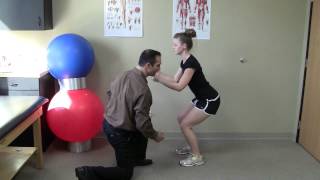Pain 101: Knee Pain
What is Headache Pain?
Knee pain may be caused by an injury or from irritation over a period of time. Certain muscle imbalances make one more susceptible to knee pain or injuries. Tightness in musculature around the knee, weakness in the hip and knee stabilizers, and problems in the foot can all increase one’s likelihood of an injury or pain in the knee.
Types of Knee Pain
Patellar Tendinitis
Patellar tendinitis is an inflammation of the large tendon which runs down the front of the knee. This can lead to pain in the front of the knee when walking or navigating stairs.
Arthritis
Arthritis is an inflammation or a wearing out of the cartilage in the knee joint which serves to prevent the bones from rubbing against each other. When this protective layer is inflamed or worn out, the bones can rub, which can result in pain and stiffness and difficulty navigating steps, walking and squatting.
Chondromalacia
Chondromalacia is a softening and irritation of the cartilage under the knee cap. It causes pain under the knee cap especially when walking up and down stairs and squatting.
Meniscus Tear
Meniscus tear is a tear of one of the two crescent-shaped cartilages in the knee joint. Meniscus tears most often occur in active young people involved in sports, athletes and older adults who have degeneration associated with age.
Ligament Injuries
Ligament injuries are tears or sprains of the ligaments that help to support the knee joint. A person with ligament injuries will often feel as if the knee will “give out” and frequently complain of pain and swelling.
Bursitis
Bursitis is an inflammation of the “bursa” or a fluid-filled sack protecting the joint. Bursitis can develop from extended periods of kneeling such as gardening or a fall on the knee.
STEPS TO KNEE PAIN RELIEF
REST
It is important when you are experiencing knee pain to limit your activity and rest so that your knee can heal.
COLD PACKS
Apply a cold pack to your knee to help reduce pain and inflammation in the joints and muscles. To prevent damage to skin and surrounding tissue, cold packs should only be applied in 15 minute intervals.
STRETCH
If you don’t have increased pain with movement, stretching and increasing the range of motion of your knee can help loosen up the muscles surrounding your knee and decrease the pain.
PHYSICAL THERAPY
Physical therapy consists of hands-on treatment to loosen muscles and joints, education on proper walking and movement to decrease pain, instruction on stretching and strengthening exercises to restore mobility and strength, and modalities such as electrical stimulation, cold/heat packs and ultrasound.
KNEE PAIN EXERCISES
Following are a few exercises you can perform that may help alleviate pain. Please go to LIFE+ for more videos that may help you. Please consult your physician before trying these, and stop if you experience any pain or discomfort.







